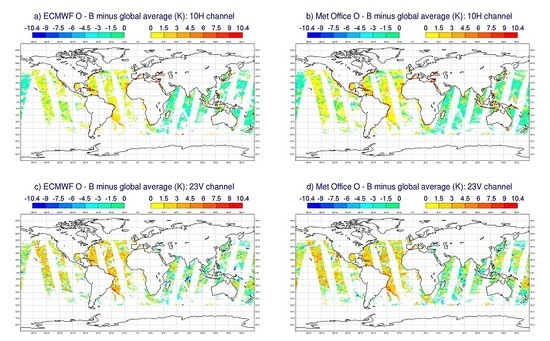Assessment of New Satellite Missions within the Framework of Numerical Weather Prediction
Abstract
1. Introduction
2. Materials and Methods
2.1. NWP Assessments of Current Satellite Missions
2.1.1. Satellite Data Description
2.1.2. Data Assimilation Configurations
2.1.3. Data Selection
2.2. The GRUAN Processor
2.2.1. Sampling for GRUAN Comparison
2.2.2. Treatment of Uncertainty
2.2.3. Application to MetOp-SG Future Missions
3. Results
3.1. Calibration and Validation of Current Missions
3.1.1. Detection of Geographic Biases
3.1.2. Detection of Time-Dependent Biases
3.1.3. Detection of Radio Frequency Interference
3.1.4. Inter-Satellite Comparison
3.2. Calibration and Validation of Future Missions
3.2.1. IASI-NG
3.2.2. MWS
4. Discussion
5. Conclusions
Author Contributions
Funding
Acknowledgments
Conflicts of Interest
References
- Loew, A.; Bell, W.; Brocca, L.; Bulgin, C.E.; Burdanowitz, J.; Calbet, X.; Donner, R.V.; Ghent, D.; Gruber, A.; Kaminski, T.; et al. Validation practices for satellite-based Earth observation data across communities. Rev. Geophys. 2017, 55, 779–817. [Google Scholar] [CrossRef]
- Newman, S.M.; Knuteson, R.O.; Zhou, D.K.; Larar, A.M.; Smith, W.L.; Taylor, J.P. Radiative transfer validation study from the European Aqua Thermodynamic Experiment. Q. J. R. Meteorol. Soc. 2009, 135, 277–290. [Google Scholar] [CrossRef]
- Larar, A.M.; Smith, W.L.; Zhou, D.K.; Liu, X.; Revercomb, H.; Taylor, J.P.; Newman, S.M.; Schlüssel, P. IASI spectral radiance validation inter-comparisons: Case study assessment from the JAIVEx field campaign. Atmos. Chem. Phys. 2010, 10, 411–430. [Google Scholar] [CrossRef]
- Müller, R. Calibration and Verification of Remote Sensing Instruments and Observations. Remote Sens. 2014, 6, 5692–5695. [Google Scholar] [CrossRef]
- Cao, C.Y.; Weinreb, M.; Xu, H. Predicting simultaneous nadir overpasses among polar-orbiting meteorological satellites for the intersatellite calibration of radiometers. J. Atmos. Ocean. Technol. 2004, 21, 537–542. [Google Scholar] [CrossRef]
- Wang, L.K.; Goldberg, M.; Wu, X.Q.; Cao, C.Y.; Iacovazzi, R.A.; Yu, F.F.; Li, Y.P. Consistency assessment of Atmospheric Infrared Sounder and Infrared Atmospheric Sounding Interferometer radiances: Double differences versus simultaneous nadir overpasses. J. Geophys. Res. Atmos. 2011, 116, 11. [Google Scholar] [CrossRef]
- Bell, W.; English, S.J.; Candy, B.; Atkinson, N.; Hilton, F.; Baker, N.; Swadley, S.D.; Campbell, W.F.; Bormann, N.; Kelly, G.; et al. The assimilation of SSMIS radiances in numerical weather prediction models. IEEE Trans. Geosci. Remote Sens. 2008, 46, 884–900. [Google Scholar] [CrossRef]
- Geer, A.J.; Bauer, P.; Bormann, N. Solar Biases in Microwave Imager Observations Assimilated at ECMWF. IEEE Trans. Geosci. Remote Sens. 2010, 48, 2660–2669. [Google Scholar] [CrossRef]
- Lu, Q.F.; Bell, W.; Bauer, P.; Bormann, N.; Peubey, C. Characterizing the FY-3A Microwave Temperature Sounder Using the ECMWF Model. J. Atmos. Ocean. Technol. 2011, 28, 1373–1389. [Google Scholar] [CrossRef]
- Saunders, R.W.; Blackmore, T.A.; Candy, B.; Francis, P.N.; Hewison, T.J. Monitoring Satellite Radiance Biases Using NWP Models. IEEE Trans. Geosci. Remote Sens. 2013, 51, 1124–1138. [Google Scholar] [CrossRef]
- Lu, Q.F.; Bell, W. Characterizing Channel Center Frequencies in AMSU-A and MSU Microwave Sounding Instruments. J. Atmos. Ocean. Technol. 2014, 31, 1713–1732. [Google Scholar] [CrossRef][Green Version]
- Carminati, F.; Migliorini, S.; Ingleby, B.; Bell, W.; Lawrence, H.; Newman, S.; Hocking, J.; Smith, A. Using reference radiosondes to characterise NWP model uncertainty for improved satellite calibration and validation. Atmos. Meas. Technol. 2019, 12, 83–106. [Google Scholar] [CrossRef]
- Saunders, R.; Hocking, J.; Turner, E.; Rayer, P.; Rundle, D.; Brunel, P.; Vidot, J.; Roquet, P.; Matricardi, M.; Geer, A.; et al. An update on the RTTOV fast radiative transfer model (currently at version 12). Geosci. Model Dev. 2018, 11, 2717–2732. [Google Scholar] [CrossRef]
- Rabier, F.; Jarvinen, H.; Klinker, E.; Mahfouf, J.F.; Simmons, A. The ECMWF operational implementation of four-dimensional variational assimilation. I: Experimental results with simplified physics. Q. J. R. Meteorol. Soc. 2000, 126, 1143–1170. [Google Scholar] [CrossRef]
- Rawlins, F.; Ballard, S.P.; Bovis, K.J.; Clayton, A.M.; Li, D.; Inverarity, G.W.; Lorenc, A.C.; Payne, T.J. The Met Office global four-dimensional variational data assimilation scheme. Q. J. R. Meteorol. Soc. 2007, 133, 347–362. [Google Scholar] [CrossRef]
- English, S.J.; Renshaw, R.J.; Dibben, P.C.; Smith, A.J.; Rayer, P.J.; Poulsen, C.; Saunders, F.W.; Eyre, J.R. A comparison of the impact of TOVS and ATOVS satellite sounding data on the accuracy of numerical weather forecasts. Q. J. R. Meteorol. Soc. 2000, 126, 2911–2931. [Google Scholar]
- Imaoka, K.; Kachi, M.; Kasahara, M.; Ito, N.; Nakagawa, K.; Oki, T. Instrument performance and calibration of AMSR-E and AMSR2. Netw. World Remote Sens. 2010, 38, 13–16. [Google Scholar]
- Yang, H.; Weng, F.Z.; Lv, L.Q.; Lu, N.M.; Liu, G.F.; Bai, M.; Qian, Q.Y.; He, J.K.; Xu, H.X. The FengYun-3 Microwave Radiation Imager On-Orbit Verification. IEEE Trans. Geosci. Remote Sens. 2011, 49, 4552–4560. [Google Scholar] [CrossRef]
- He, J.Y.; Zhang, S.W.; Wang, Z.Z. Advanced Microwave Atmospheric Sounder (AMAS) Channel Specifications and T/V Calibration Results on FY-3C Satellite. IEEE Trans. Geosci. Remote Sens. 2015, 53, 481–493. [Google Scholar] [CrossRef]
- Draper, D.W.; Newell, D.A.; Wentz, F.J.; Krimchansky, S.; Skofronick-Jackson, G.M. The Global Precipitation Measurement (GPM) Microwave Imager (GMI): Instrument Overview and Early On-Orbit Performance. IEEE J. Sel. Top. Appl. Earth Obs. Remote Sens. 2015, 8, 3452–3462. [Google Scholar] [CrossRef]
- Draper, D.W.; Newell, D.A.; McKague, D.S.; Piepmeier, J.R. Assessing Calibration Stability Using the Global Precipitation Measurement (GPM) Microwave Imager (GMI) Noise Diodes. IEEE J. Sel. Top. Appl. Earth Obs. Remote Sens. 2015, 8, 4239–4247. [Google Scholar] [CrossRef]
- Wentz, F.J.; Draper, D. On-Orbit Absolute Calibration of the Global Precipitation Measurement Microwave Imager. J. Atmos. Ocean. Technol. 2016, 33, 1393–1412. [Google Scholar] [CrossRef]
- Bauer, P.; Geer, A.J.; Lopez, P.; Salmond, D. Direct 4D-Var assimilation of all-sky radiances. Part I: Implementation. Q. J. R. Meteorol. Soc. 2010, 136, 1868–1885. [Google Scholar] [CrossRef]
- Geer, A.J.; Bauer, P.; Lopez, P. Direct 4D-Var assimilation of all-sky radiances. Part II: Assessment. Q. J. R. Meteorol. Soc. 2010, 136, 1886–1905. [Google Scholar] [CrossRef]
- Bauer, P.; Moreau, E.; Chevallier, F.; O’Keeffe, U. Multiple-scattering microwave radiative transfer for data assimilation applications. Q. J. R. Meteorol. Soc. 2006, 132, 1259–1281. [Google Scholar] [CrossRef]
- Liu, Q.H.; Weng, F.Z.; English, S.J. An Improved Fast Microwave Water Emissivity Model. IEEE Trans. Geosci. Remote Sens. 2011, 49, 1238–1250. [Google Scholar] [CrossRef]
- Kazumori, M.; English, S.J. Use of the ocean surface wind direction signal in microwave radiance assimilation. Q. J. R. Meteorol. Soc. 2015, 141, 1354–1375. [Google Scholar] [CrossRef]
- Geer, A.J.; Bauer, P. Observation errors in all-sky data assimilation. Q. J. R. Meteorol. Soc. 2011, 137, 2024–2037. [Google Scholar] [CrossRef]
- Petty, G.W.; Katsaros, K.B. Precipitation observed over the South China Sea by the Nimbus-7 Scanning Multichannel Microwave Radiometer during winter MONEX. J. Appl. Meteorol. 1990, 29, 273–287. [Google Scholar] [CrossRef][Green Version]
- Petty, G.W. Physical retrievals of over-ocean rain rate from multichannel microwave imagery .1. Theoretical characteristics of normalized polarization and scattering indexes. Meteorol. Atmos. Phys. 1994, 54, 79–99. [Google Scholar] [CrossRef]
- Lonitz, K.; Geer, A. New Screening of Cold-Air Outbreak Regions Used in 4D-Var All-Sky Assimilation. EUMETSAT/ECMWF Fellowship Programme Research Report No. 35. 2015. Available online: https://www.ecmwf.int/node/10777 (accessed on 11 May 2020).
- Newman, S.; Bell, W.; Salonen, K. Calibration/Validation Study of AMSR2 on GCOM-W1. GAIA-CLIM Deliverable Report D4.2. 2015. Available online: http://www.gaia-clim.eu/system/files/workpkg_files/D4.2_Individual%20reports%20on%20validation%20of%20satellites%20v1.pdf (accessed on 11 May 2020).
- Lawrence, H.; Carminati, F.; Bell, W.; Bormann, N.; Newman, S.; Atkinson, N.; Geer, A.; Migliorini, S. An Evaluation of FY-3C MWRI and Assessment of the Long-Term Quality of FY-3C MWHS-2 at ECMWF and the Met Office. GAIA-CLIM Deliverable Report D4.5. 2017. Available online: http://www.gaia-clim.eu/system/files/document/D4.5%20Individual%20Reports%20on%20validation%20of%20satellites%20V2.pdf (accessed on 11 May 2020).
- Lawrence, H.; Carminati, F.; Goddard, J.; Newman, S.; Bell, W.; Bormann, N.; English, S.; Atkinson, N. Individual Reports on Validation of Satellites, Version 3. GAIA-CLIM Deliverable Report D4.6. 2017. Available online: http://www.gaia-clim.eu/system/files/document/d4.6.pdf (accessed on 11 May 2020).
- Dirksen, R.J.; Sommer, M.; Immler, F.J.; Hurst, D.F.; Kivi, R.; Vomel, H. Reference quality upper-air measurements: GRUAN data processing for the Vaisala RS92 radiosonde. Atmos. Meas. Technol. 2014, 7, 4463–4490. [Google Scholar] [CrossRef]
- Immler, F.J.; Dykema, J.; Gardiner, T.; Whiteman, D.N.; Thorne, P.W.; Vomel, H. Reference Quality Upper-Air Measurements: Guidance for developing GRUAN data products. Atmos. Meas. Technol. 2010, 3, 1217–1231. [Google Scholar] [CrossRef]
- Holmlund, K.; Bojkov, B.; Klaes, D.; Schlussel, P. IEEE. The Joint Polar System: Towards the Second Generation EUMETSAT Polar System. 2017 IEEE Int. Geosci. Remote Sens. Symp. (Igarss) 2017, 2779–2782. [Google Scholar] [CrossRef]
- Schlüssel, P.; Kayal, G. Introduction to the Next Generation EUMETSAT Polar System (EPS-SG) Observation Missions. In Proceedings of the Conference on Sensors, Systems, and Next-Generation Satellites XXI, Warsaw, Poland, 11–14 September 2017. [Google Scholar]
- D’Addio, S.; Kangas, V.; Klein, U.; Loiselet, M.; Mason, G. IEEE. The Microwave Radiometers on-board MetOp Second Generation satellites. 2014 IEEE Int. Workshop Metrol. Aerosp. (Metroaerospace) 2014, 599–604. [Google Scholar] [CrossRef]
- Bermudo, F.; Rousseau, S.; Pequignot, E.; Bernard, F. IEEE. IASI-NG program: A New Generation of Infrared Atmospheric Sounding Interferometer. 2014 IEEE Int. Geosci. Remote Sens. Symp. (Igarss) 2014, 1373–1376. [Google Scholar] [CrossRef]
- Xie, X.X.; Wu, S.L.; Xu, H.X.; Yu, W.M.; He, J.K.; Gu, S.Y. Ascending-Descending Bias Correction of Microwave Radiation Imager on Board FengYun-3C. IEEE Trans. Geosci. Remote Sens. 2019, 57, 3126–3134. [Google Scholar] [CrossRef]
- Auligne, T.; McNally, A.P.; Dee, D.P. Adaptive bias correction for satellite data in a numerical weather prediction system. Q. J. R. Meteorol. Soc. 2007, 133, 631–642. [Google Scholar] [CrossRef]
- Zou, X.L.; Tian, X.X.; Weng, F.Z. Detection of Television Frequency Interference with Satellite Microwave Imager Observations over Oceans. J. Atmos. Ocean. Technol. 2014, 31, 2759–2776. [Google Scholar] [CrossRef]
- English, S.; Geer, A.; Lawrence, H.; Meunier, L.-F.; Prigent, C.; Kilic, L.; Johnson, B.; Chen, M.; Bell, W.; Newman, S. A reference model for ocean surface emissivity and backscatter from the microwave to the infrared. In Proceedings of the 21st International TOVS Study Conference, Darmstadt, Germany, 29 November–5 December 2017. [Google Scholar]
- Lawrence, H.; Bormann, N.; English, S.J. Uncertainties in the permittivity model for seawater in FASTEM and implications for the calibration/validation of microwave imagers. J. Quant. Spectrosc. Radiat. Transf. 2020, 243. [Google Scholar] [CrossRef]
- Shepherd, T.G.; Polichtchouk, I.; Hogan, R.J.; Simmons, A.J. Report on Stratosphere Task Force, ECMWF Technical Memorandum 824. 2018. Available online: https://www.ecmwf.int/en/elibrary/18259-report-stratosphere-task-force (accessed on 11 May 2020).
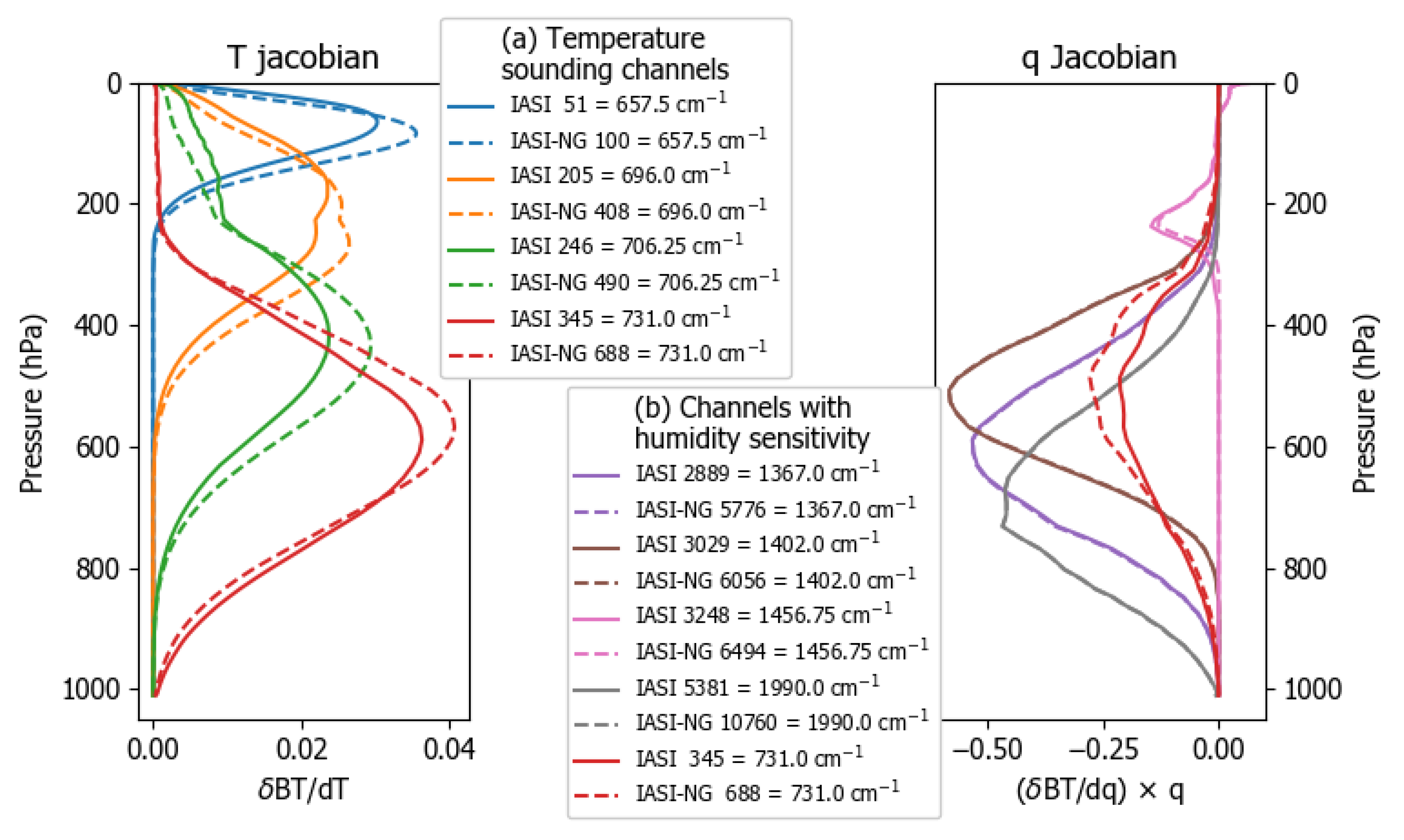
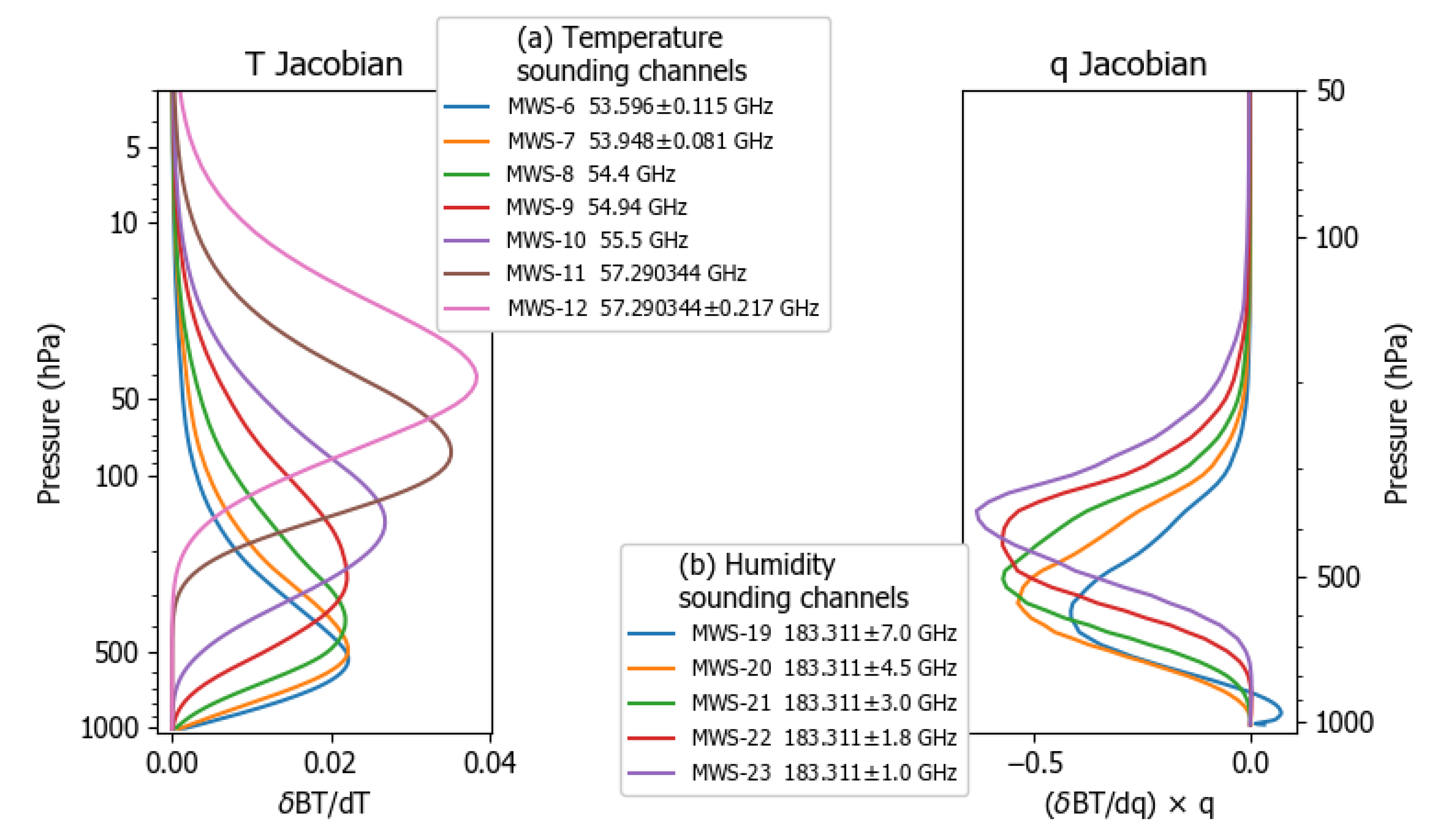
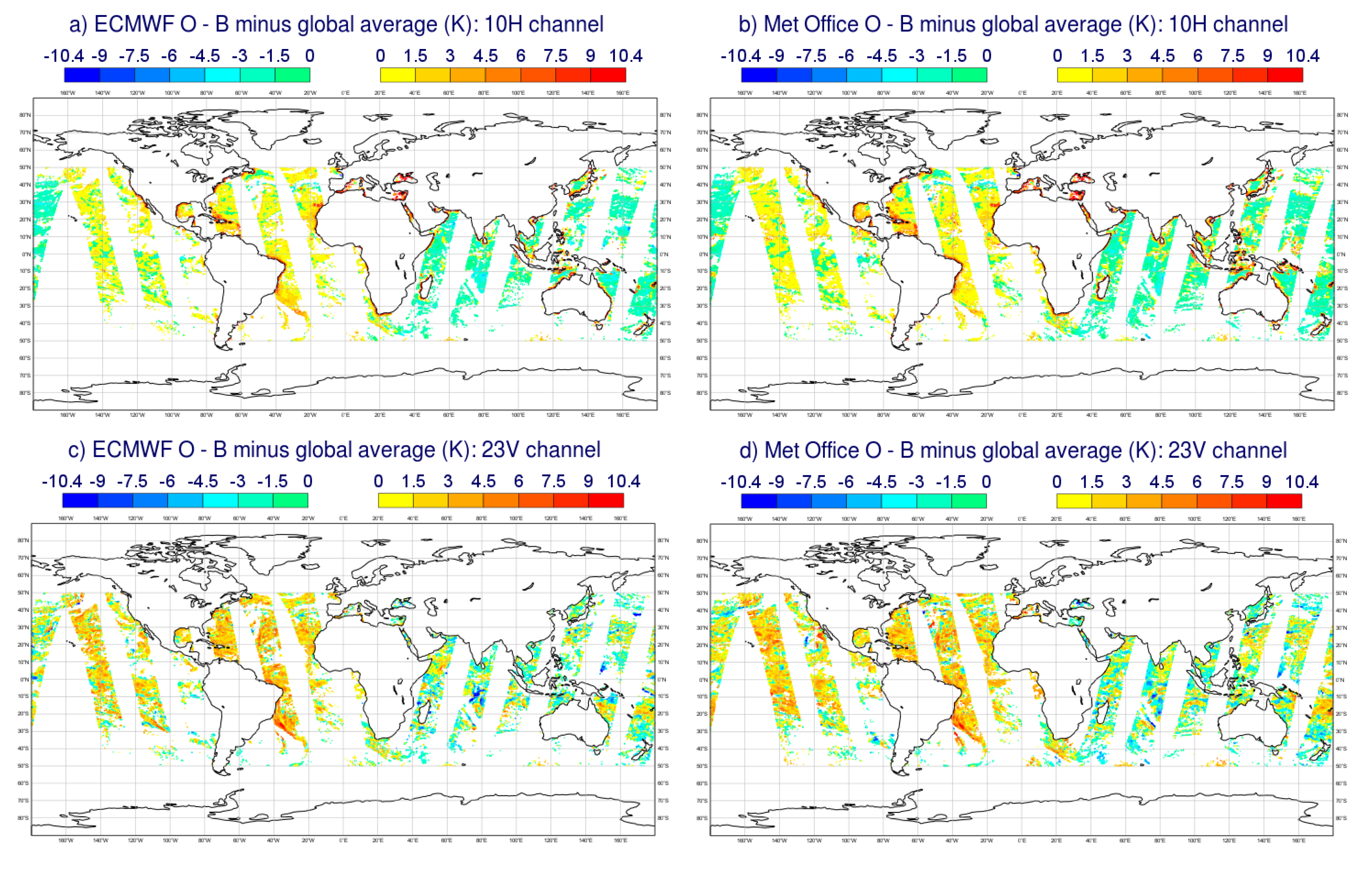

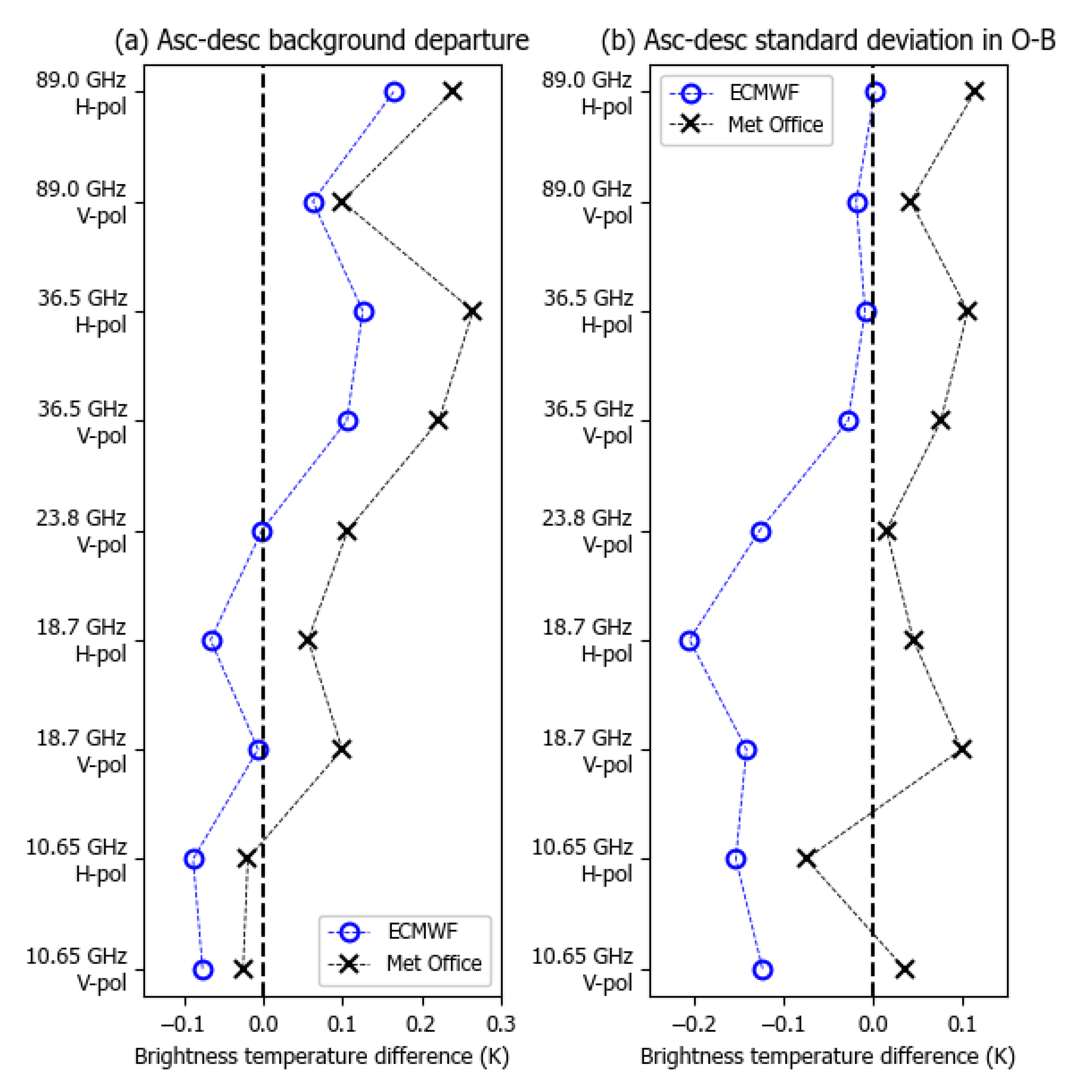

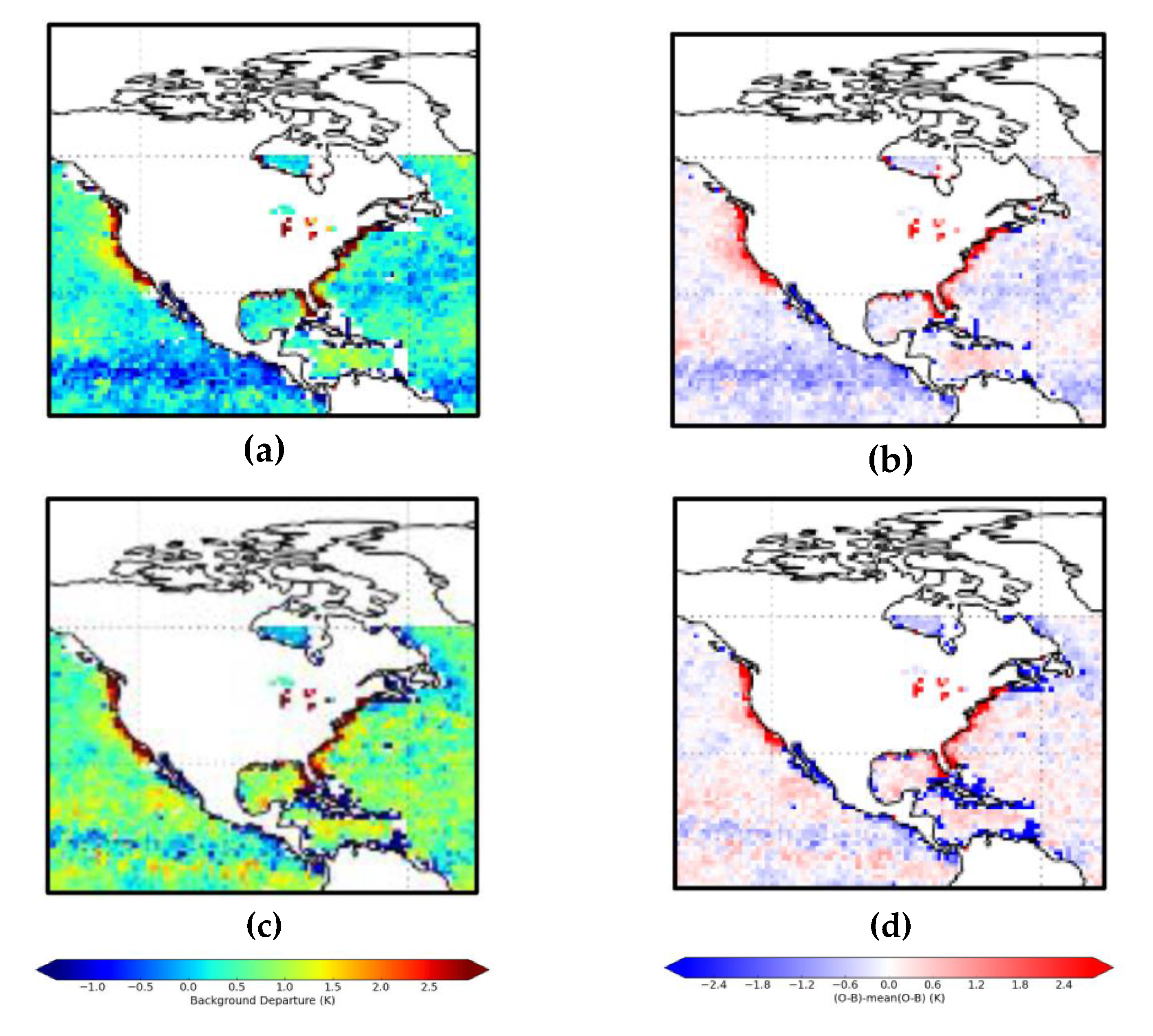
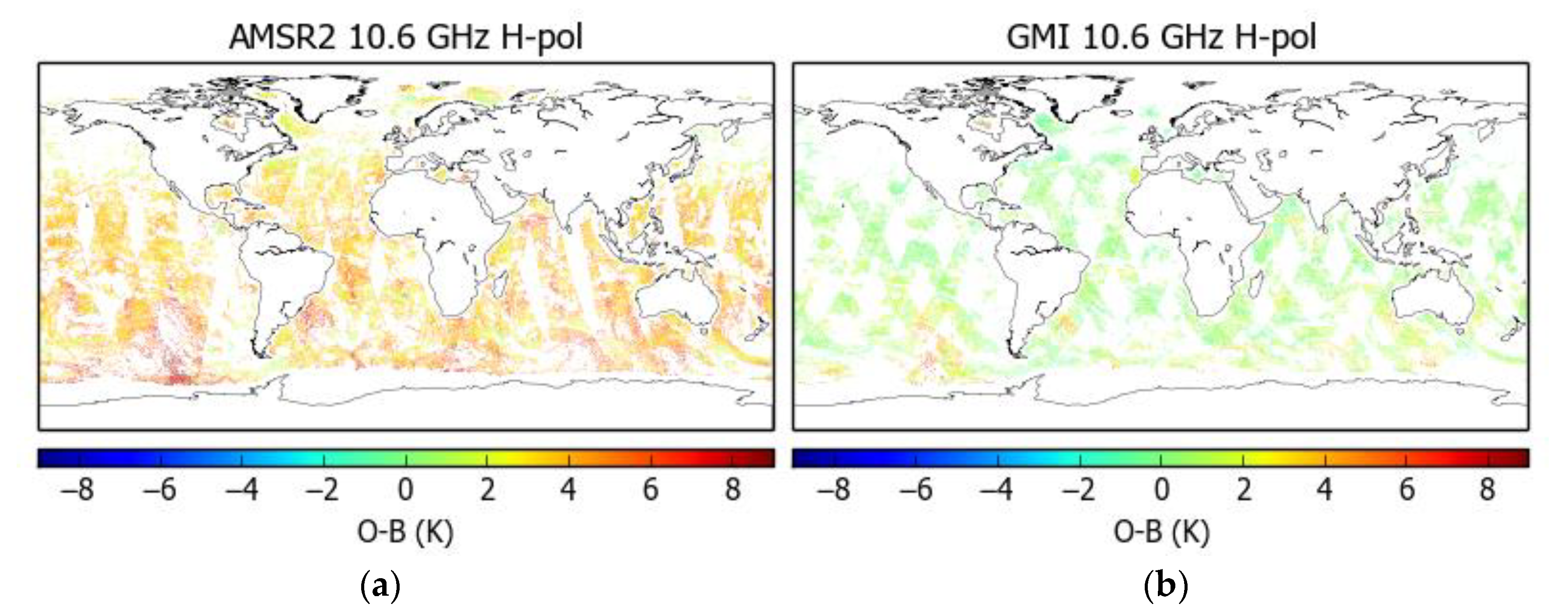
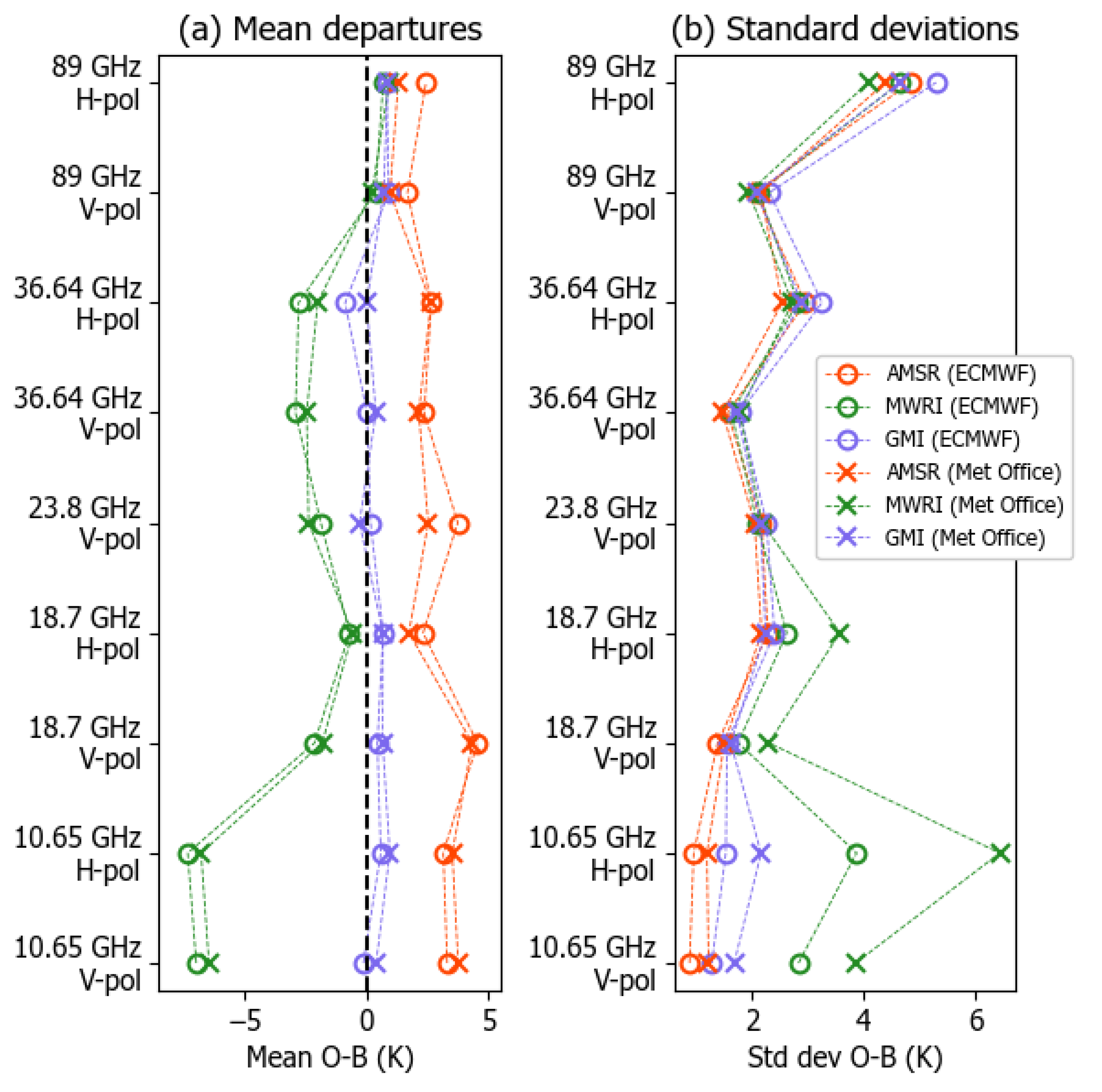
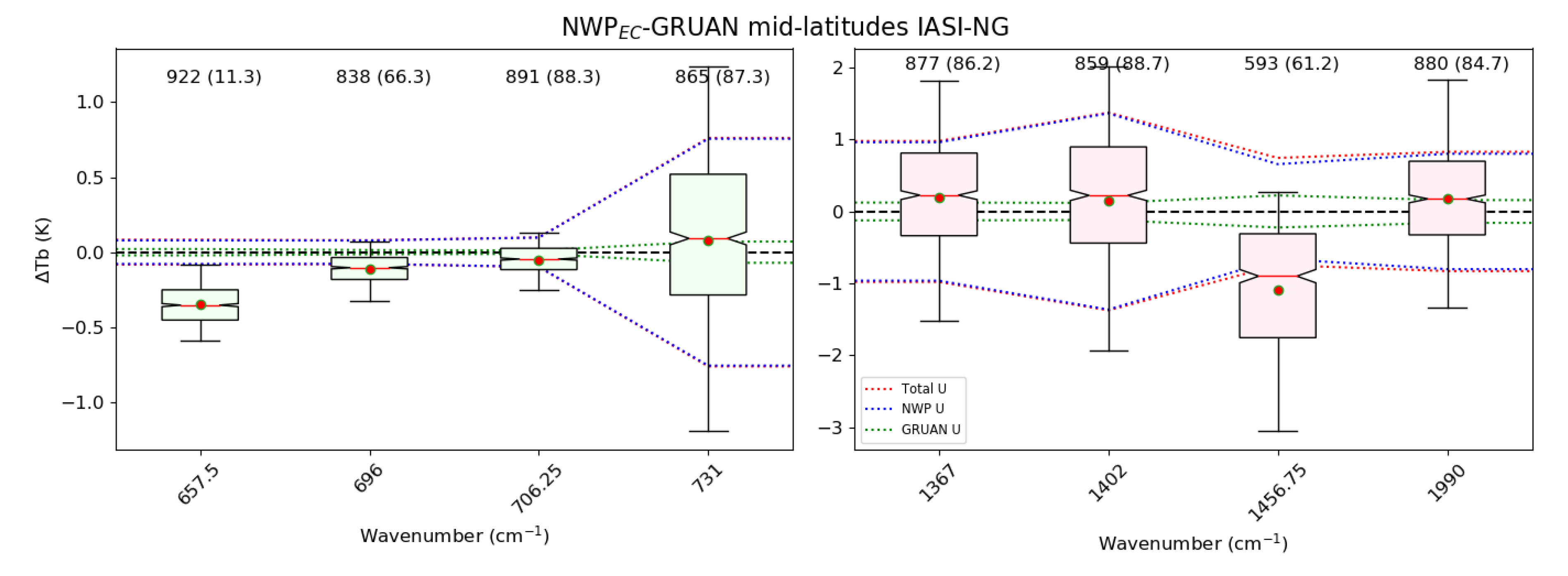

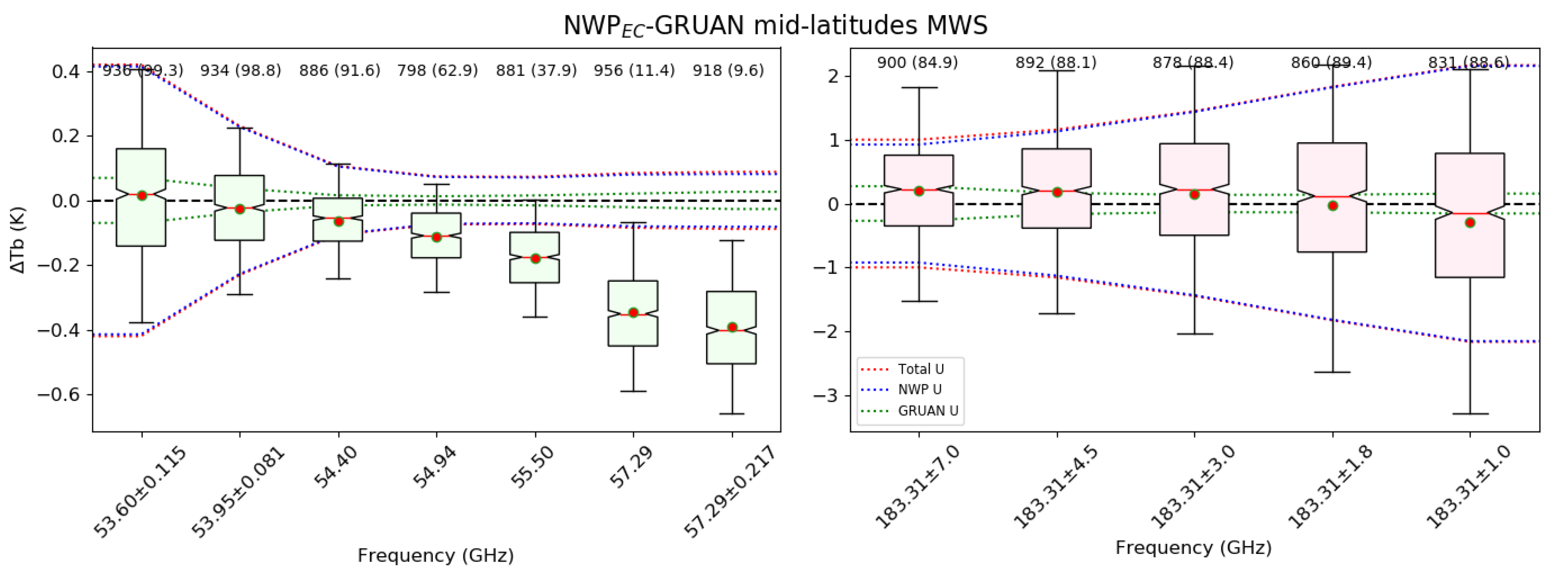
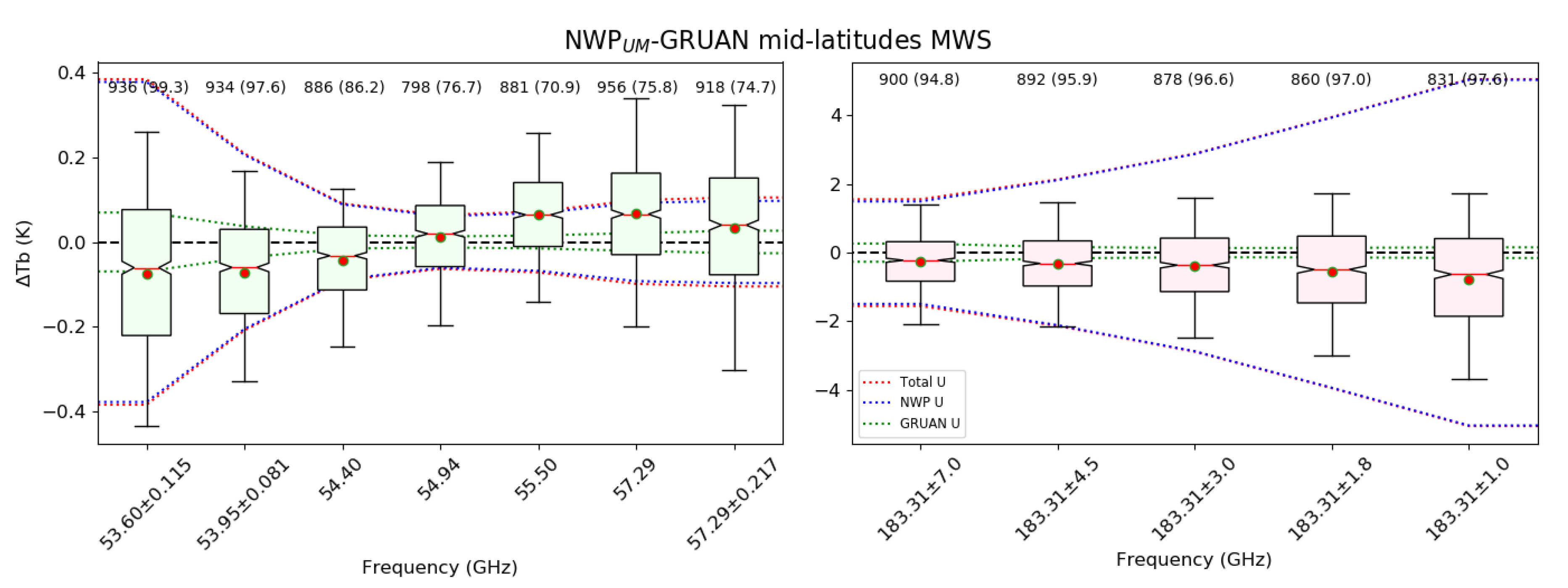
| Instrument | Platform | Channel Set (GHz) 1 |
|---|---|---|
| AMSR2 | GCOM-W1 | 6.9, 7.3, 10.65, 18.7, 23.8, 36.5, 89.0 |
| MWHS-2 | FY-3C | 89.0H, 118.75V ± (0.08, 0.2, 0.3, 0.8, 1.1, 2.5, 3.0, 5.0), 150.0H, 183.3V ± (7.0, 4.5, 3.0, 1.8, 1.0) |
| MWRI | FY-3C | 10.65, 18.7, 23.8, 36.5, 89.0 |
| GMI | GPM | 10.65, 18.7, 23.8V, 36.5, 89.0, 166.5, 183.3V± (7.0, 3.0) |
| Geographic Area | GRUAN Site | Latitude | Longitude | Altitude (m) |
| Northern latitudes | Barrow, USA | 71.32° | −156.61° | 8 |
| Ny-Ålesund, Norway | 78.92° | 11.93° | 5 | |
| Sodankylä, Finland | 67.37° | 26.63° | 179 | |
| Mid-latitudes | Lamont, USA | 36.60° | −97.49° | 320 |
| Cabauw, Netherlands | 51.97° | 4.92° | 1 | |
| Lindenberg, Germany | 52.21° | 14.12° | 98 | |
| Tateno, Japan | 36.06° | 140.13° | 27 | |
| Sub-tropics | Graciosa, Portugal | 39.09° | −28.03° | 30 |
| Tenerife, Spain | 28.32° | −16.38° | 115 |
© 2020 by the authors. Licensee MDPI, Basel, Switzerland. This article is an open access article distributed under the terms and conditions of the Creative Commons Attribution (CC BY) license (http://creativecommons.org/licenses/by/4.0/).
Share and Cite
Newman, S.; Carminati, F.; Lawrence, H.; Bormann, N.; Salonen, K.; Bell, W. Assessment of New Satellite Missions within the Framework of Numerical Weather Prediction. Remote Sens. 2020, 12, 1580. https://doi.org/10.3390/rs12101580
Newman S, Carminati F, Lawrence H, Bormann N, Salonen K, Bell W. Assessment of New Satellite Missions within the Framework of Numerical Weather Prediction. Remote Sensing. 2020; 12(10):1580. https://doi.org/10.3390/rs12101580
Chicago/Turabian StyleNewman, Stuart, Fabien Carminati, Heather Lawrence, Niels Bormann, Kirsti Salonen, and William Bell. 2020. "Assessment of New Satellite Missions within the Framework of Numerical Weather Prediction" Remote Sensing 12, no. 10: 1580. https://doi.org/10.3390/rs12101580
APA StyleNewman, S., Carminati, F., Lawrence, H., Bormann, N., Salonen, K., & Bell, W. (2020). Assessment of New Satellite Missions within the Framework of Numerical Weather Prediction. Remote Sensing, 12(10), 1580. https://doi.org/10.3390/rs12101580





